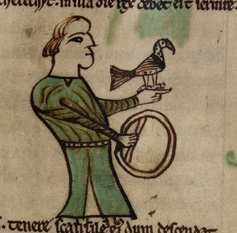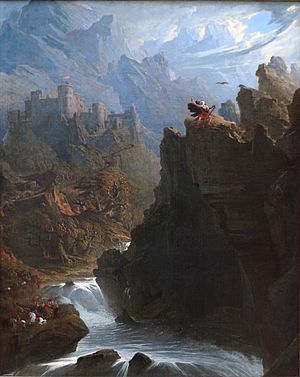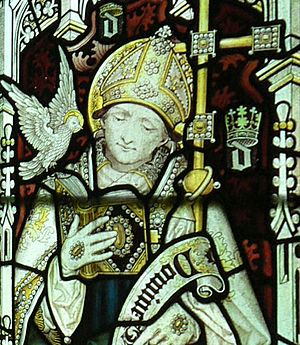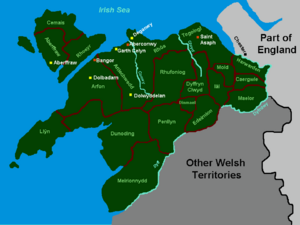Culture of Gwynedd during the High Middle Ages facts for kids
Culture and Society in Gwynedd during the High Middle Ages looks at life in north Wales between the years 1000 and 1300. This time came after the Early Middle Ages and before the Late Middle Ages. Gwynedd was a powerful kingdom located in the north of Wales.
During this period, people in Gwynedd made great progress. They developed Medieval Welsh literature, especially the poetry of the Beirdd y Tywysogion (Poets of the Princes). These poets were connected to the royal court of Gwynedd. They also improved schools for bards (poets and storytellers). Plus, they continued to develop Cyfraith Hywel (Welsh Law). All these things helped create a strong Welsh identity. This was important because the Anglo-Normans were trying to take over Wales. This struggle ended with Edward I's conquest of Wales.
Gwynedd's traditional land included Anglesey (Ynys Môn) and all of north Wales. It stretched from the River Dyfi in the south to the River Dee in the northeast. The Irish Sea was to the north and west. Lands that used to be part of Powys bordered Gwynedd to the southeast. Gwynedd was strong partly because of its mountainous land. This made it hard for invaders to fight there and take control.
Before this time, Gwynedd faced many challenges. There were more Viking raids and takeovers by other Welsh princes. This caused a lot of political and social trouble. The old ruling family, the Aberffraw family, was pushed out. By the mid-11th century, Gruffydd ap Llywelyn united Gwynedd with the rest of Wales. Then, the Normans invaded between 1067 and 1100.
Later, the Aberffraw family returned to power in Gwynedd. Strong leaders like Gruffudd ap Cynan and Owain Gwynedd in the 11th and 12th centuries helped Gwynedd grow. Then, Llywelyn the Great and his grandson Llywelyn ap Gruffudd in the 13th century led to the rise of the Principality of Wales. This new state was based in Gwynedd.
By the 13th century, the Principality of Wales showed it could be an independent country. Historian Dr John Davies said that Wales was truly independent. As part of this Principality, Gwynedd kept its Welsh laws and customs. It ruled itself until the Edwardian Conquest of Wales in 1282.
Contents
Life in Gwynedd: Homes, Buildings, and Jobs
When Gruffudd ap Cynan died in 1137, Gwynedd was much more stable. No foreign army could cross the Conwy River into upper Gwynedd. This peace, provided by Gruffudd and his son Owain Gwynedd (from 1101 to 1170), allowed people to plan for the future. They no longer feared that their homes and harvests would be burned by invaders.
How People Lived and Built Things
Settlements in Gwynedd became more permanent. Buildings made of stone started to replace those made of wood. Many stone churches were built across Gwynedd. They were often whitewashed with lime, making them shine. It was said that "Gwynedd was bespangled with them as is the firmament with stars." Gruffudd built stone churches at his royal manors. This led to other churches being rebuilt in stone, like those in Penmon, Aberdaron, and Towyn, in the Norman style.
By the 13th century, Gwynedd was the heart of the Principality of Wales. This area, called Pura Wallia, covered about three-quarters of modern Wales. It stretched from Anglesey to Machen, and from near Chester to near Cydweli. By 1271, Prince Llywelyn ap Gruffudd ruled about 200,000 people. This was almost three-quarters of the total Welsh population.
Population Growth and New Jobs
The population grew across Europe in the 13th century, but it was even more noticeable in Wales. During Llywelyn II's rule, about 10 percent of the people lived in towns. Also, "unfree slaves... had long disappeared" from Pura Wallia. This was due to big social changes in the 11th century. More free men meant the prince could gather a much larger and more skilled army.
The growing population in Gwynedd led to more types of jobs. Tax records from Meirionnydd show 37 different jobs right before the Edwardian Conquest in 1282. These included eight goldsmiths, four professional bards (poets), and 26 shoemakers. There was also a doctor in Cynwyd and an hotel keeper in Maentwrog. Plus, there were 28 priests, two of whom had gone to university. Many fishermen, administrators, and craftsmen also lived there.
The average temperature in Wales was a bit warmer than today. This meant more land could be used for farming, which was a big help for the country.
Trade and Economy
Better trade routes were important for Gwynedd. They brought new inventions like the windmill, the fulling-mill (for making cloth), and the horse collar. The horse collar doubled the power of horses for pulling things.
Gwynedd exported many goods. These included cattle, animal skins, cheese, timber, horses, wax, dogs, hawks, and fleeces. They also exported flannel, which became very popular with the growth of fulling mills. Flannel was the second most important export after cattle. In return, Gwynedd imported salt, wine, wheat, and other luxury items from places like London and Paris. Most importantly for defense, Gwynedd also imported iron and special weapons. The English used Wales's need for these imports to weaken Gwynedd during conflicts.
Welsh Culture: Poetry, Stories, and Music
The stable rule of the Aberffraw family helped Welsh culture grow. This was especially true for literature. Stories say that Gruffudd I helped improve the groups of bards and musicians. Welsh literature during this time was strong and full of purpose. New ideas reached Wales, even from the invaders. Contact with other parts of Europe also made Welsh people prouder of their heritage.
The Poets of the Princes
In Welsh, the poets of this time are called Beirdd y Tywysogion (Poets of the Princes) or Y Gogynfeirdd (The Less Early Poets). The main collection of their poems is the Hendregadredd manuscript. This book of court poetry was put together at Cistercian Strata Florida Abbey from about 1282 to 1350.
Bards were trained professionals and part of a special group, like a guild. Their rights and duties were written in Welsh law. These poets worked within a well-developed literary culture, using specific rules for writing and speaking. It was common for poetry skills to be passed down in families. For example, the poet Meilyr Brydydd had a poet son and at least two poet grandsons. But poetry was also taught formally in bardic schools, often run by the pencerdd (chief poet).
Welsh law stated that the prince kept several bards at his court. The most important were the pencerdd and the bardd teulu. The pencerdd, or head bard, was the best in his field. He had a special chair in the royal court, honored next to the prince's heir. When the pencerdd performed, he sang twice: once for God, and once for the prince. The bardd teulu was part of the prince's teulu (household guard). He sang for the soldiers before battles and after successful campaigns. The bardd teulu also wrote and sang for the princess, often in private. A private performance by a bard showed high status. The clêr were traveling poet-musicians. They were seen as the lowest level of poets and were often called mere "minstrels" by the court poets.
The poetry often praised the prince's fighting skills. The language used was old-fashioned and sometimes hard to understand, like the praise poetry of Taliesin. There were also religious poems and poems praising women.
After the last native Prince of Wales died in 1282, this tradition slowly faded. The elegy (a sad poem) by Gruffudd ab yr Ynad Coch about the death of Llywelyn ap Gruffudd is one of the most famous poems from this time. Other important poets linked to Gwynedd's court include:
- Meilyr Brydydd, active around 1100–1137; the earliest of the Gogynfeirdd
- Llywarch ap Llywelyn, active 1174/5-1220; he sang about Llywelyn the Great's victory over Dafydd ab Owain
- Bleddyn Fardd, active around 1258–1284
- Cynddelw Brydydd Mawr; active around 1155–1200
- Dafydd Benfras, active around 1220–58
Hywel ab Owain Gwynedd (died 1170) was a different kind of poet. He was known as the Poet-Prince. As the son and heir of Prince Owain Gwynedd, he was not a professional poet.
The Welsh Church in Gwynedd
Early Christian Traditions
Before the Norman invasions (1067–1101), Christians in Gwynedd shared many spiritual traditions. These came from the Celtic Christianity of the Early Middle Ages.
Welsh church leaders questioned how much the Pope could tell them what to do. This was especially true for priests marrying, the role of women in the Church and society, and the status of children born outside marriage. Church law often clashed with native Welsh law and customs. Welsh bishops also said that the Archbishop of Canterbury had no authority over them. Historian John Davies believed it was risky for Welsh bishops to submit to a church authority that would be heavily influenced by an English king.
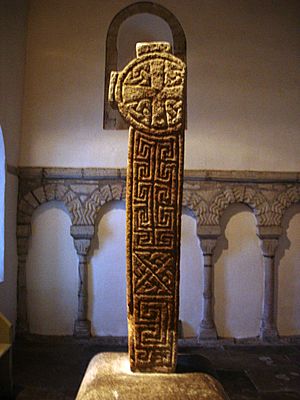
By the 11th century, the Welsh Church had three main areas, called dioceses. These were closely connected by a strong sense of community. They shared religious practices but were independent. Their borders were not always clear. This organization worked well because Welsh settlements were mostly rural. They favored local and independent monastic communities called clasau (singular: clas).
Clasau were run by an abod (abbot). They had several small wooden churches and sleeping huts. Welsh monks valued asceticism (a simple, strict way of life). The most famous Welsh ascetic was St. David from the 6th century. He created rules for monks that stressed hard work, encouraged vegetarianism, and promoted self-control. Women had a higher status in Welsh law and custom than in other parts of Europe. They could hold semi-priestly roles in the Welsh Church. Since celibacy (not marrying) was not a big part of the Welsh Church, many priests married and had children. Some monasteries were family projects. Some church jobs even became hereditary. For many Welsh people, being a monk or nun was a family way of life dedicated to Christ. Marriage was seen as a social agreement under Welsh law, so divorce was recognized by the Welsh Church.
The Diocese of Bangor was the main church center for all of Upper and Lower Gwynedd.
Changes After Norman Invasion
After the Norman invasion, Gruffydd I of Gwynedd supported the importance of the episcopal see (main church) of Bangor. He paid for the building of Bangor Cathedral between 1120 and 1139. Gruffydd was buried in a tomb in the presbytery of Bangor Cathedral.
How Gwynedd Was Governed
The Aberffraw family's main area of influence in north Wales included the Isle of Anglesey, which was their early base. It also included Gwynedd Uwch Conwy (Gwynedd above the Conwy River, or Upper Gwynedd) and the Perfeddwlad ("the Middle Country"), also known as Gwynedd Is Conwy (Gwynedd below the Conwy, or Lower Gwynedd). They gained more land through agreements or by fighting. They also won back land lost to Marcher lords, especially in Ceredigion, Powys Fadog, and Powys Wenwynwyn. However, these areas were always seen as additions to Gwynedd, not as part of Gwynedd itself.
The size of the kingdom changed depending on how strong the ruler was. The kingdom was managed using Welsh customs. It was divided into 13 cantrefi (hundreds). Each cantref was supposed to have one hundred settlements, or trefi. Most cantrefi were further divided into cymydau (English: commotes).
Gwynedd at War
Fighting in Gwynedd and Wales was very difficult. This was clear during the Norman invasions between 1081 and 1101. If defenders could block roads, control river crossings, or mountain passes, and control the coastline, then fighting in Wales was too risky for invaders. With control of the Menai, an army could gather on Anglesey. Without it, an army could be stuck there. Also, any force on Anglesey could stop the Welsh from getting the island's large harvest. And the Welsh could launch surprise attacks from mountain forts or hidden forests.
The Welsh were famous for their skilled archers. They also learned from the Normans. Over generations of fighting and contact with the Normans, Gruffydd I and other Welsh leaders learned about knighthood. They adapted these skills for Wales. By Gruffydd's death in 1137, Gwynedd could send hundreds of heavily armed cavalry into battle. They also had their traditional archers and foot soldiers.
In the end, Wales was defeated because the English navy got better. They could block or take over areas important for food, like Anglesey. Without food, any large Welsh army trapped in the mountains would have to break up. During the revolt of Owain Glyndŵr, the Welsh used new skills they learned for guerilla tactics and quick raids. Owain was so good at using the mountains that many English soldiers thought he was a magician who could control nature. During the Hundred Year's War, Welsh longbowmen were hired by the English army to fight in France.


